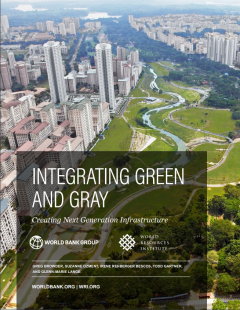
Natural systems have long been recognized for their ability to deliver or contribute to core infrastructure services—water purification and storage, flood management, irrigation, and electricity generation. But, until now, there has been a lack of clear guidance on how to integrate green infrastructure into human-built projects so that they deliver better services at lower cost.
In this report, the World Bank and World Resources Institute show how the next generation of infrastructure projects can tap natural systems and, where appropriate, integrate green and gray infrastructure. This report is, therefore, essential reading for those responsible for delivering infrastructure services. Water and power utilities, storm and flood management agencies, and irrigation departments can use the guidelines to integrate natural approaches into their plans. Public officials can learn to how to enable green-gray infrastructure development through improved policies, laws, and regulations. Ministries of Finance and Budget can gain insights on how to approach financing, often a major barrier for infrastructure, by opening new financing channels from mission-driven investors and governments.
Highlights:
- Traditional infrastructure systems worldwide rely on built solutions to support the smooth and safe functioning of societies. In the face of multiplying environmental threats, this approach alone can no longer provide the climate resiliency and level of services required in the 21st century.
- Natural systems such as forests, floodplains, and soils can contribute to clean, reliable water supply and protect against floods and drought. In many circumstances, combining this “green infrastructure” with traditional “gray infrastructure,” such as dams, levees, reservoirs, treatment systems, and pipes, can provide next generation solutions that enhance system performance and better protect communities.
- Service providers such as water utilities, flood management agencies, irrigation agencies, and hydropower companies can deliver more cost-effective and resilient services by integrating green infrastructure into their plans. However, to guide its appropriate use in mainstream infrastructure programs, green infrastructure must be as rigorously evaluated and carefully designed as gray projects.
- This report offers service providers a framework to evaluate green infrastructure from a technical, environmental, social, and economic perspective, and to assess key enabling conditions, with illustrative examples. It also provides guidance for policymakers and development partners, who must set the incentives and enabling conditions to mainstream solutions that unite green and gray infrastructure.
